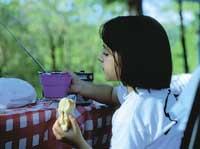Children and diabetes: let's talk about food
If we look at the way of life of children with diabetes, we will realize that there are many factors that we must keep in mind continuously. Among other things, along with good eating habits, they must fully control kcal and carbohydrates in all meals of the day, depending on the dose of insulin imposed on them by the doctor and the sport they practice.
Each child's energy needs also depend on factors such as age, weight, height, sex, and exercise. If we analyze the energy obtained through food, we observe that carbohydrates account for 50 to 55% of energy: carbohydrates that are rapidly absorbed (sugar, honey, sweet drinks, candy, pastries, chocolate, sugary cereals and other foods containing a small amount of sugar) should be excluded from the diet. All of them should be out of the diet diabetic children. For their part, sugars derived from milk and fruit pass into the blood faster than the rest, so they must represent 15% of the carbohydrates and the rest of the polysaccharides. By not being able to use natural sweeteners, diabetic children can therefore use artificial seasonings, but always to the appropriate extent, since artificial can also have harmful effects, even if not known accurately.
As for complex carbohydrates, fiber (fiber) is recommended, as it hinders the rapid rise of body glucose levels after eating; in the intestine it slows absorption and therefore decreases sticker needs.
Diabetic children need the same amount of fat as recommended in the proper intake of anyone, that is, 30% of daily energy needs. But beware of foods with saturated fats, which increase the processes of diabetes. Discard therefore bollikas and the like.

As for proteins, diabetic children need higher amounts than normal, because they perform a structural function and help growth, so the process of these children is more complicated, so it is advisable that their protein content is high, around 15-20%. The main sources of protein are skinless chicken, rabbit, veal and white fish, mixed with green beans with cereals, for its high protein content, for being low-fat foods.
Mineral salts, vitamins and water should be consumed by diabetic children as they are taken by any of us. In any case, if polyuria appears, water losses should be covered and sometimes two liters of water should be drunk a day.
Once we have seen what foods are convenient and undesirable, we will now analyze how they should be eaten. It is advisable to make 5 or 6 meals a day, never buttered in a single meal, like bread with chocolate. On the contrary, glucids should be mixed with foods rich in protein and fats such as bread cheese, tuna, occasionally sausages, etc. In addition, to avoid a sudden increase in glucose levels it is necessary to avoid heavy meals.
We are aware that everything we have exposed shows a rather black panorama. Keep in mind, however, that at present it is increasingly easy to find products specifically prepared for diabetics, since substitutes for products totally prohibited by diabetics, such as cakes, nougat, jam, etc. There are no problems eating once at work, but beware of excesses, as some of these replacement products can also damage them.
In this article we talk about food, but when we talk about diabetes is not this, as we know, the only factor to consider. According to experts, thorough knowledge of the disease is critical to addressing the risks of diabetes. The child must know well the characteristics of the disease and potential problems, own himself. Only in this way will it manage, facing the problems that may arise from this chronic disease, to lead a comfortable life.





